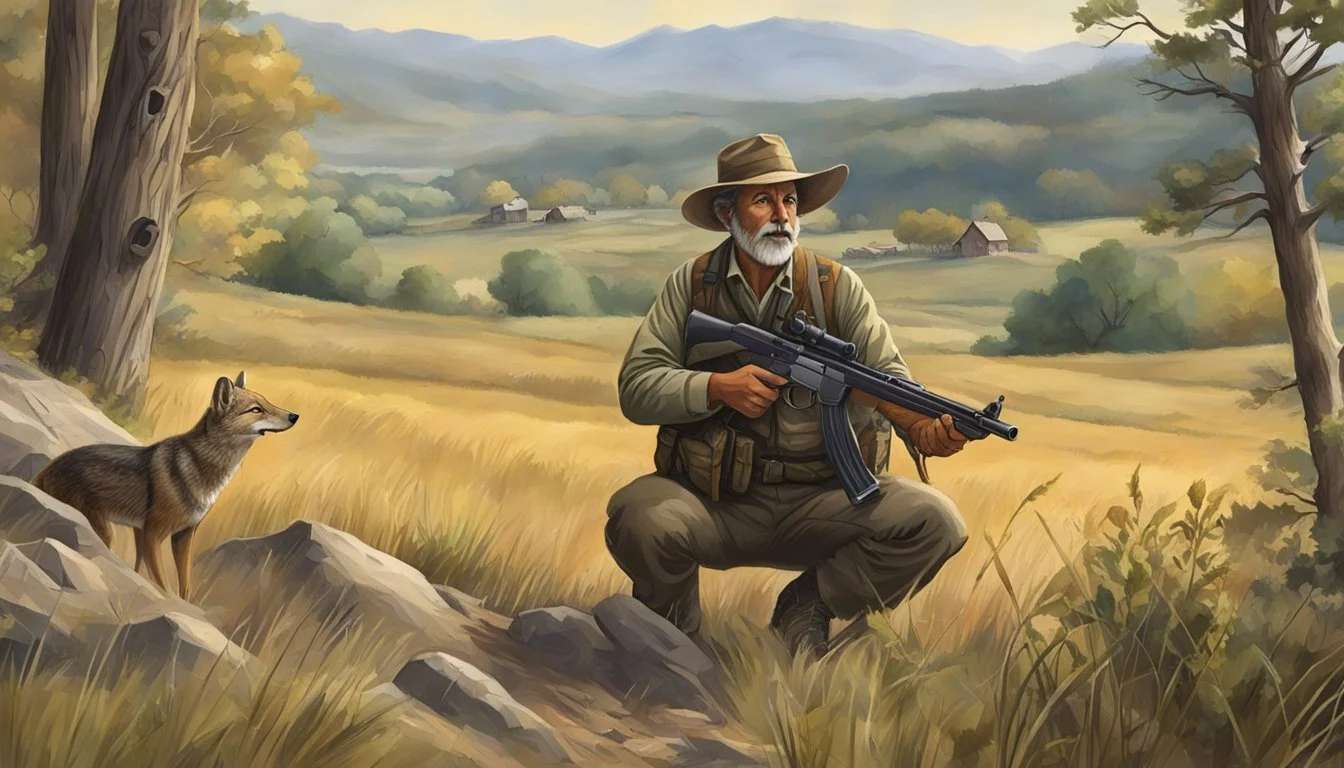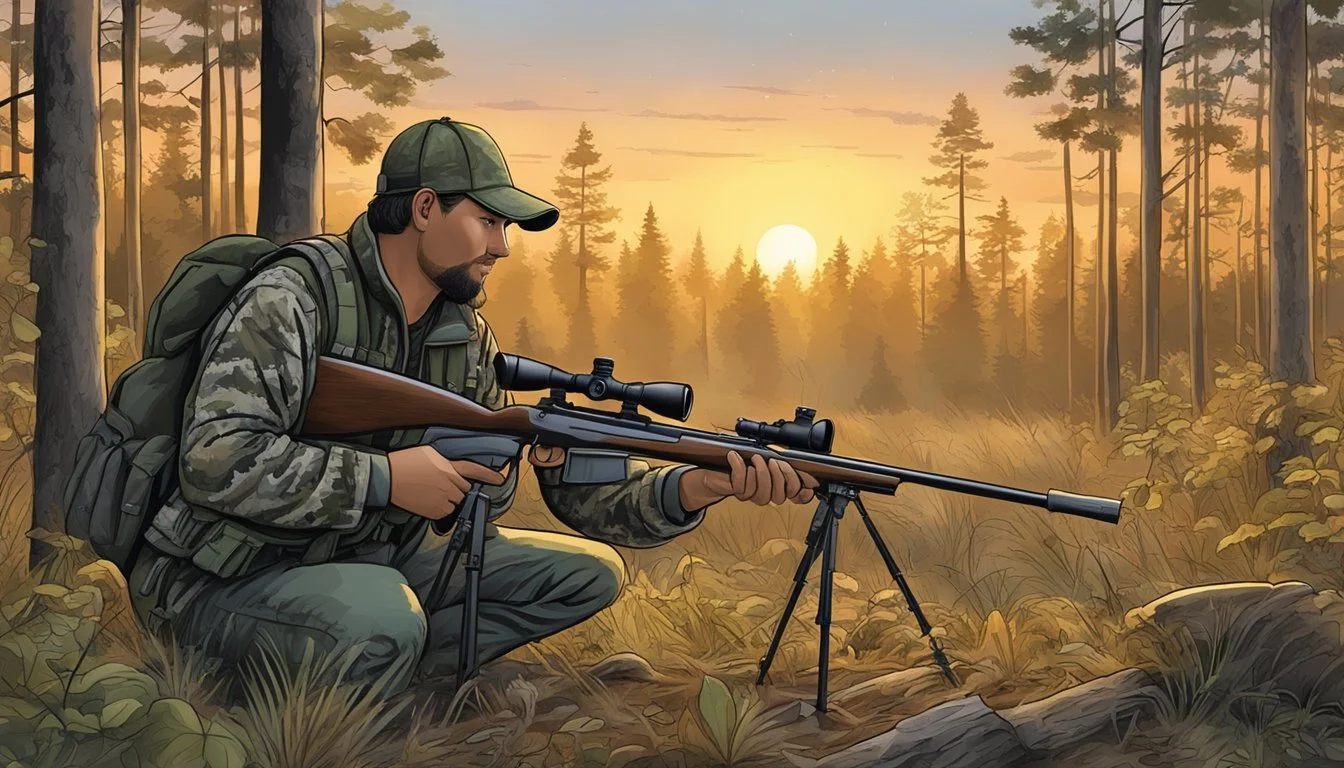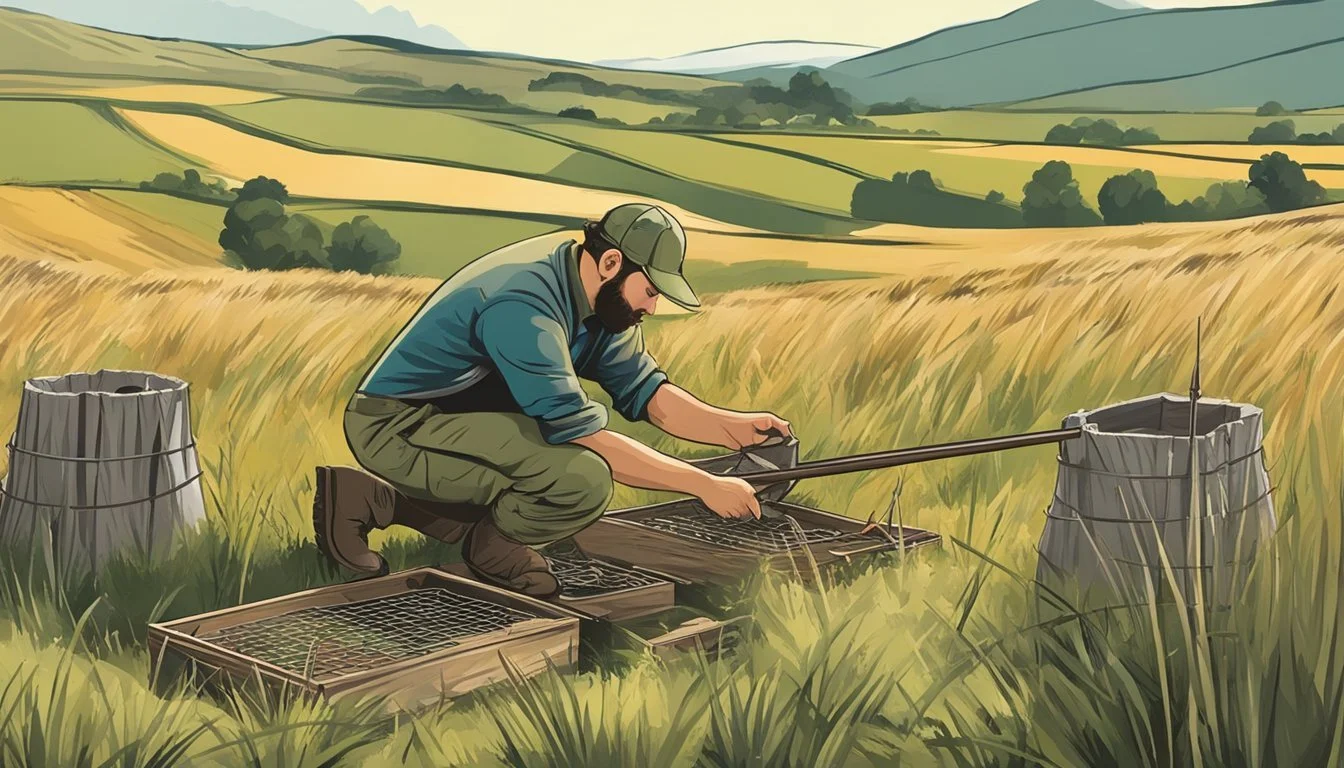Varmint Hunting for Beginners
Essential Tips and Techniques
Varmint hunting offers an engaging foray into wildlife management and outdoor sport. With species such as the coyote, rabbits, and raccoons classified as 'varmints' due to their abundance and impact on various ecosystems and human activities, the practice is widespread. It serves a dual purpose of controlling populations that can otherwise become pests and providing hunters with a challenging pursuit that sharpens their skills year-round.
Equipped with the right knowledge and equipment, anyone can take up stalking vermin. It's necessary to learn about the preferred habitats, feeding patterns, and characteristics of these animals to hunt responsibly and effectively. Regulations vary by state and may dictate the timing, methods, and equipment used for hunting varmint species. Beginners must familiarize themselves with these rules to ensure a legal and ethical hunt.
For those starting out, resources are available to understand the finer points of stalking varmint. While the learning curve can be steep, the community of vermin hunters often shares advice on tactics, gear, and techniques suitable for these small game.
Understanding Varmint Hunting
Stalking varmint hunting is a practice aimed at controlling populations of certain wildlife species which can be detrimental to agriculture and ecosystems. Through targeted hunting, vermin control supports crop protection and disease prevention.
What Are Varmints?
Varmints are typically small to medium-sized wildlife species considered pests. These animals are often predators such as the coyote or invasive species like feral hogs that pose threats to livestock and crops. Big game animals are excluded from the category of varmint.
Coyote: Predatory and adaptive, they can challenge farmers by preying on livestock.
Rabbits: They breed rapidly and can decimate crops, affecting farm yields.
Feral Hogs: Invasive and destructive, these animals uproot land and compete with native species.
Legal and Ethical Considerations
Hunt seasons and regulations are established to manage wildlife populations effectively. Stalking varmint often has more relaxed seasons due to the year-round nuisance these animals can pose.
Licensing: Hunters require appropriate licenses and should be aware of state-specific regulations.
Species-Specific Laws: Certain vermin may have specific legal protections or hunt restrictions.
Ethical Hunt Practices: Stalkers are encouraged to follow fair chase principles and ensure quick, humane kills.
Benefits of a Varmint Hunt
Farmers and landowners utilize stalking varmint as a tool for property and livestock protection. The practice also serves as a form of active wildlife management, helping to maintain ecological balance.
Ecosystem Balance: Managing predator populations helps protect other wildlife.
Agricultural Benefits: Reduces crop damage and financial loss for farmers.
Hunting Skill Maintenance: Offers stalkers opportunities to practice skills outside of traditional hunt seasons.
By understanding the role and regulations of stalking vermin, individuals can engage in this activity responsibly, ensuring the safety of the ecosystem and assisting agricultural communities.
Equipment Essentials
In a vermin hunt, success hinges on having the right gear. The hunter's rifle, optics, and support equipment should all serve the specific challenges posed by hunting smaller, often more elusive game animals. Precision and stealth are key, and the following information will guide beginners through selecting the essential equipment they'll need.
Choosing the Right Varmint Rifle
When selecting a vermin rifle, factors like the size of the quarry and hunt distance play vital roles. For smaller critters such as prairie dogs, a .17 HRM caliber gun like the Savage Arms 93R bolt-action is ideal. For predators such as the coyote, a larger caliber like a .223, found in rifles like the Ruger American Rifle Predator, is more suitable. The gun must be comfortable to handle, accurate, and chambered for an appropriate caliber that balances flat trajectory with minimal damage to pelts.
Understanding Optics and Scopes
Optics play a significant role in stalking vermin, requiring precision to make long shots at small targets. Scopes with adjustable magnification are best, allowing the hunter to fine-tune their vision based on distance and the size of the object. Features to look for in a scope include:
Clear reticle for precise aiming
High-quality glass for better image clarity
Adequate magnification (at least 9x for longer distances)
Support Gear: Bipods and Shooting Sticks
For stability when aiming at targets, bipods or shooting sticks are non-negotiable for many varmint hunters. They provide a steady platform to shoot long-range, essential in stalking varmints where precision is key. A hunter can choose between a bipod, which attaches directly to the gun, or shooting sticks that can be quickly repositioned:
Bipods offer hands-free support and typically fold up for easy transportation.
Shooting sticks are ideal for varmint stalkers who move frequently and need repeated quick setup.
Additional Gear and Safety Equipment
Besides the rifle and optics, a successful varmint hunter's kit includes additional gear:
Ammo: Match-grade ammunition increases accuracy for precise shots.
Camouflage: Full-body camo, including a face mask, helps the hunter blend in.
Scent Hiders: Masks human odor to avoid alerting prey.
Safety is paramount in any hunt. Stalkers should always wear protective gear such as ear protection and safety glasses. It is also imperative to have a first-aid kit on hand in case of emergencies.
Preparation for the Hunt
Before setting out on a varmint hunt, many hunters must thoroughly prepare by scouting for the ideal locations, understanding the behavior of critters, and mastering various hunt techniques.
Scouting and Identifying Hunting Spots
An effective stalker recognizes the importance of scouting. They invest time in locating areas with abundant signs of varmint activity, such as tracks, droppings, or disturbed vegetation. Habitat is key; varmints often frequent edges where different environments meet, like fields bordering forests. Stalkers utilize maps and satellite imagery to pinpoint potential spots and then visit to confirm the presence of critters.
Key Elements:
Food Sources: Look for areas with abundant forage.
Water Sources: Identify nearby water bodies.
Cover: Consider spots that provide shelter for varmints.
Understanding Animal Behavior
Successful stalkers understand their quarry's behavior. They know that varmints are often crepuscular, active during dusk and dawn. Knowledge of feeding habits, seasonal patterns, and preferred shelter helps stalkers determine when and where to hunt. For example, the jack rabbit favors brushy areas near open fields.
Behavioral Patterns:
Coyote: Generally more active at night and can be called in using distress calls.
Jack Rabbit: Forage at dawn and dusk, often near cover.
Choosing Specific Varmints
Successful stalking varmint requires a clear understanding of the habits, habitats, and characteristics of the target species to effectively control their populations and prevent damage to crops and livestock.
The Coyote Hunt
Coyotes are often killed for their fur and to protect livestock. Hunting this cunning predator requires patience and stealth. Guns in .223 caliber are recommended for their balance of range and stopping power. For coyote hunting, electronic calls that mimic the sound of prey or distressed critters can be highly effective.
Prairie Dogs and Ground Squirrels
These small and fast-moving critters can decimate crops and create hazardous burrows. A cartridge like the .17 HRM offers many shooters the precision needed for such small objects. When dealing with prairie dogs and ground squirrels, utilizing a scope with high magnification such as 6-24x ensures better object identification for these elusive critters.
Crow and Small Bird Strategies
A crow hunt challenges stalkers with fast-moving birds that are extremely wary. Shotguns with #4 or #6 shot best serve for their speed and spread when aiming at crows in flight. For small birds, the .22 caliber short range gun provides accuracy without excessive damage to the fur, valuable for stalkers who also wish to shoot them to preserve the pelt.
Controlling Feral Hogs and Larger Pest Control
Feral pigs and hogs are tough and resilient, making them a challenge for stalkers. It's important to use a high-powered big gun, like the .308, to ensure a humane and effective takedown. For large pests, stalkers must prioritize shot placement; thus scopes that allow for both quick target acquisition and extended range are essential.
Stalking Varmint Tactics
Effective stalking vermin strategies require a blend of stealth, decoy deployment, and an understanding of the distinct challenges presented by both a day and a night hunt. Additionally, long-range shooting skills are often crucial due to the wary nature of these creatures.
Effective Use of Decoys and Calls
Using decoys and calls can significantly increase the chances of a successful hunt. Decoys add a visual attractant, while calls mimic the sounds of prey or distress calls to lure vermin into range. It's critical to:
Use a variety of calls to simulate different scenarios.
Place decoys in a visible yet natural setting.
Day vs. Night Hunts
The choice between a day hunt and a night hunt depends on the target species and their habits. Many varmints are nocturnal, making a night hunt a more fruitful approach, although it introduces challenges such as decreased visibility and cooler temperatures. During the day, varmints may be less active but are easier to spot when hunted.
Long-Range Shooting Considerations
Stalking varmint often involves long-range shooting, where precision is paramount. Factors to consider include:
Windage and elevation adjustments for accuracy.
High-caliber gun and scopes for long-distance targeting.
Agility in adjusting shooting positions and adapting to the animal's movements will enhance the likelihood of a successful hunt.
Ballistics and Ammunition
In stalking varmint, selecting the right ammunition is crucial for successful, ethical hunts of small animals. Ballistics—the science of projectile motion—plays an integral role in ammunition choice and ultimately affects the accuracy and effectiveness of a shot. Understanding calibers, larger cartridges, high velocity bullet types, and reloading techniques is essential for optimizing performance.
Caliber and Cartridge Selection
When choosing the caliber and cartridges for stalking varmints, many stalkers must consider the size and range of their target species. A varmint cartridge such as the .17 HMR and .22 WMR for smaller varmints, provides a flat trajectory and minimized risk of ricochet. For medium-sized vermin, varmint cartridges like the .223 Remington is a top choice due to its versatility, flat shooting, and wide availability of ammunition.
.17 HMR: Ideal for small vermin at distance.
.22 WMR: A cartridge effective for small to medium-sized vermin and offers a balance between speed and impact.
.223 Remington: A preferred cartridge option for coyotes and larger vermin, provides high precision and velocity.
Bullet Types and Performance
Bullets for varmint hunts typically feature designs that promote rapid expansion to ensure a quick and humane kill. Bullet types commonly used are:
Hollow-point: Expands upon impact, increasing internal damage.
Soft-point: Offers controlled expansion and deeper penetration.
Polymer-tipped: Balances rapid expansion with aerodynamics for long-range accuracy.
Hollow-point and soft-point bullets are chosen for their immediate impact, while polymer-tipped bullets, like those found in rounds from the V-Max line from Hornady, combine precision with terminal performance.
Reloading for Precision and Economy
Reloading allows stalkers to tailor their ammunition for specific hunting scenarios, enhancing precision and potentially reducing costs. Critical components for reloading include:
Projectile: Choose a bullet that matches the intended varmint size and expected distance.
Powder: Select a powder type and charge that delivers optimal velocity for the chosen bullet.
Case and primer: Quality brass and reliable primers contribute to consistency and accuracy.
Patterns for reloading .223 Remington and any other common varmint cartridge should be guided by established data to ensure safety and reliability. Stalkers can experiment with different combinations of cartridges to achieve the desired balance of velocity, trajectory, and terminal ballistics.
Conservation and Management
In the practice of varmint hunting, the balance between animal population control and the safeguarding of ecosystems is critical. Stalkers play an essential role in conservation efforts and must be conscious of their impact on local fauna and flora.
Role of Hunters in Ecosystems
Stalkers contribute to ecological balance through regulated hunting. It helps in managing populations of certain species that may otherwise grow unchecked, potentially leading to overgrazing and habitat degradation. Ranchers often collaborate with stalkers as a method to protect their crops and livestock from potential threats posed by overabundant varmint populations.
Impact on Local Fauna and Flora
Varmint hunting, when conducted responsibly, has a direct effect on the preservation of native flora and fauna. By controlling species that are overpopulated, stalkers can reduce the strain on plant life and prevent the displacement of other wildlife species, ensuring a diverse and balanced ecosystem.
Collaboration with Conservation Efforts
Conservation agencies often work alongside stalkers to ensure sustainable hunting practices that align with ongoing conservation strategies. By maintaining open communication and cooperation with these agencies, stalkers support the protection of ecosystems while enjoying the sport of varmint hunting. This partnership fosters an environment where both wildlife management and hunting can occur responsibly and effectively.





